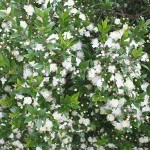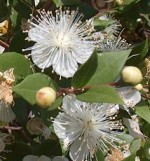 This upright evergreen shrub grown in the Mediterranean area since ancient times is a member of the Myrtaceae family that also includes clove and eucalyptus. It grows up to 30′ tall in Palestine and is bushy and fine-textured with small lustrous bright green leaves are aromatic when crushed. and branches of the plants have been used by Jews for centuries in the construction of the booths at the Feast of Tabernacles. In late spring to early summer fragrant white to pinkish white flowers with numerous stamens are produced followed by small blue-black edible berries.
This upright evergreen shrub grown in the Mediterranean area since ancient times is a member of the Myrtaceae family that also includes clove and eucalyptus. It grows up to 30′ tall in Palestine and is bushy and fine-textured with small lustrous bright green leaves are aromatic when crushed. and branches of the plants have been used by Jews for centuries in the construction of the booths at the Feast of Tabernacles. In late spring to early summer fragrant white to pinkish white flowers with numerous stamens are produced followed by small blue-black edible berries.
 The branches of the myrtle have been used by Jews for centuries in the construction of the booths at the Feast of Tabernacles and the berries used as spices. The flowers, leaves and fruit have been used in perfume making.”
The branches of the myrtle have been used by Jews for centuries in the construction of the booths at the Feast of Tabernacles and the berries used as spices. The flowers, leaves and fruit have been used in perfume making.”
Exodus 30.23 (Darby) The Lord gave Moses directions for making a holy ointment to anoint the tabernacle of the congregation.
“And thou, take best spices of liquid myrrh five hundred shekels, and of sweet cinnamon the half two hundred and fifty, and of sweet myrtle two hundred and fifty,
Nehemiah 8.15 (KJV) Ezra reads the laws of Moses.
“And that they should publish and proclaim in all their cities, and in Jerusalem, saying, Go forth unto the mount, and fetch olive branches, and pine branches, and myrtle branches, and palm branches, and branches of thick trees, to make booths, as it is written.
Isaiah 41.19 (NIV) God addresses the people.
“ I will put in the desert the cedar and the acacia, the myrtle and the olive. I will set junipers in the wasteland, the fir and the cypress together, “
Isaiah 55.13 (KJV) The benefits of coming back to the Lord are described.
Instead of the thorn shall come up the fir tree, and instead of the brier shall come up the myrtle tree: and it shall be to the LORD for a name, for an everlasting sign that shall not be cut off.
Zechariah 1 (KJV) The prophet relates one of his 10 visions.
8. “I saw by night, and behold a man riding upon a red horse, and he stood among the myrtle trees that were in the bottom; and behind him were there red horses, speckled, and white.”
10. And the man that stood among the myrtle trees answered and said, These are they whom the LORD hath sent to walk to and fro through the earth.
11. And they answered the angel of the LORD that stood among the myrtle trees, and said, We have walked to and fro through the earth, and, behold, all the earth sitteth still, and is at rest.
Myrtle likes full sun, average, moist to medium dry, well-drained soil in USDA Hardiness zones 9-11. It tolerates salt and some drought, thrives in heat but does not do well in humidity, drying winds, or wet soils. Propagation is by seed or semi-hardwood cuttings. Although plants are generally healthy they are susceptible to scale followed by sooty mold, root rot in wet soil, thrips and spider mites. The bushes take well to shearing and can be pruned into formal hedges, topiary, and bonsai. Associated with love and peace, it is a popular foliage plant in wedding bouquets.
The genus name, Myrtus, is the Greek name for the plant. The specific epithet, communis, is the classical Latin word meaning common and refers to the fact that this species is the most familiar.